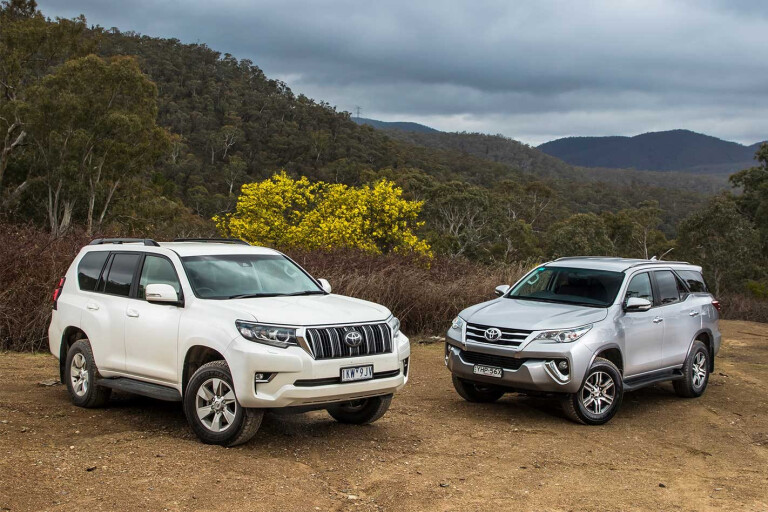
From a distance it looks like Toyota, with its Prado and Fortuner, has two distinct models selling in the same class; effectively competing against one another. Get a little closer, though, and differences emerge.
For a start, the Prado is more expensive, and while there’s a minor overlap in pricing, Prado prices effectively start where the Fortuner’s leave off – especially after Toyota lopped around $5000 off Fortuner prices in November last year.

Side-by-side the Prado is also a little bigger than the Hilux-derived Fortuner, although they both seat seven. Both also have dual-range gearing, a separate chassis and a live axle at the back, so can be classed as fair-dinkum 4x4 wagons.
Toyota arrived at this position (with the Fortuner partly competing against the Prado) because it needed to, effectively, shield Prado from competitor ute-based 4x4 wagons. That rival is primarily the Ford Everest, but also the Mitsubishi Pajero Sport and the Isuzu MU-X and Holden Trailblazer (formerly Colorado7).
Having both the Fortuner and the Prado in the same class allowed Toyota a broader price spread, and to counter Everest undercutting Prado pricing, Fortuner undercut Everest while generally matching the other three.
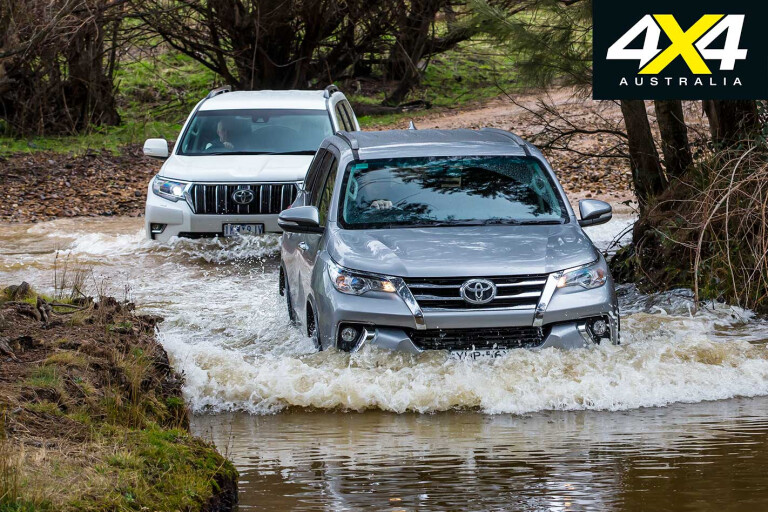
So what do buyers say about all this? Year-to-date Prado leads with 12,721 sales, well ahead of the MU-X (5819) and the Pajero-Sport (4404). Everest (3627), Fortuner (2321) and Trailblazer (1753) make up the numbers from there.
Given the Fortuner shares a Toyota badge with the Prado, and its basic powertrain, does it deserve to sell better? We take them bush to find out...
Toyota Prado

The 150 Series Prado may be near 10 years old, but it’s been Australia’s best-selling 4x4 wagon for most of that time, only slipping briefly to second spot in 2014 as Jeep’s Grand Cherokee sales soared then fizzed.
Part of that success is no doubt due to regular upgrades, which are now becoming more significant and more frequent than they were in the first five years of the 150’s life.
The most recent of those upgrades (2018 model) sees all automatic models from the base GX fitted with significant safety kit, which is led by autonomous braking, but also includes radar cruise control, lane-departure warning and automatic high-beam.

The popular-selling GXL auto model also gained the option of a premium interior, meaning buyers don’t have to step up to the considerably more expensive VX for features such as heated and ventilated front seats. The tow rating of automatic models was also increased from 2500kg to 3000kg (via a higher GCM) for the MY18 model.
These upgrades to automatic models will no doubt further limit sales of the already slow-selling manual Prado (GX and GXL only) to the point where the manual gearbox might well be discontinued.
Powertrain and Performance
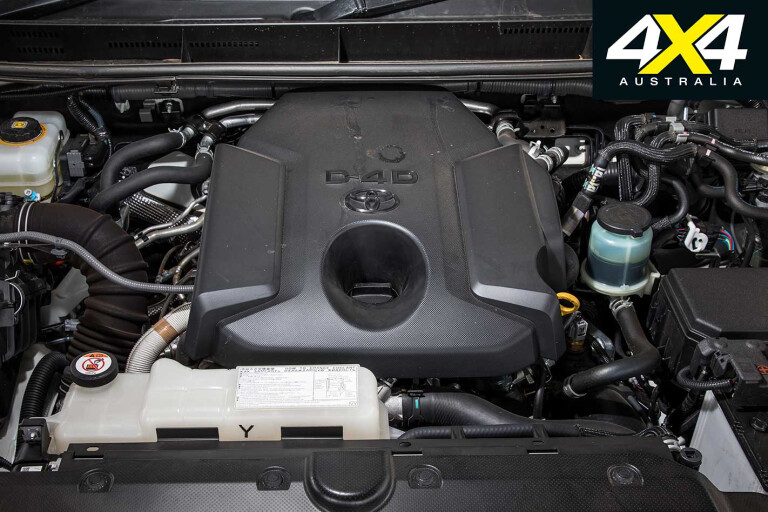
IN THE Prado’s most significant upgrade in its near 10-year life, the 150 gained an all-new 2.8-litre diesel from 2016-on when the 3.0-litre diesel – first introduced 10 years earlier in the Prado 120 – was retired due to tighter Euro 5 emission standards.
The previous five-speed automatic also went, replaced by a new six-speed automatic, also from Aisin. The Prado didn’t, however, adopt the new six-speed manual that appeared at the time in the then-new Hilux, perhaps another sign that the days are numbered for the Prado manual.
Compared to the 3.0-litre, the 2.8’s appeal lies in its refinement and civility and not in any significant performance difference. The 2.8 is still more flexible than the 3.0 and is happy to grunt it out at low revs while still spinning happily in the higher reaches, but it doesn’t really go much harder when the pedal is to the metal.
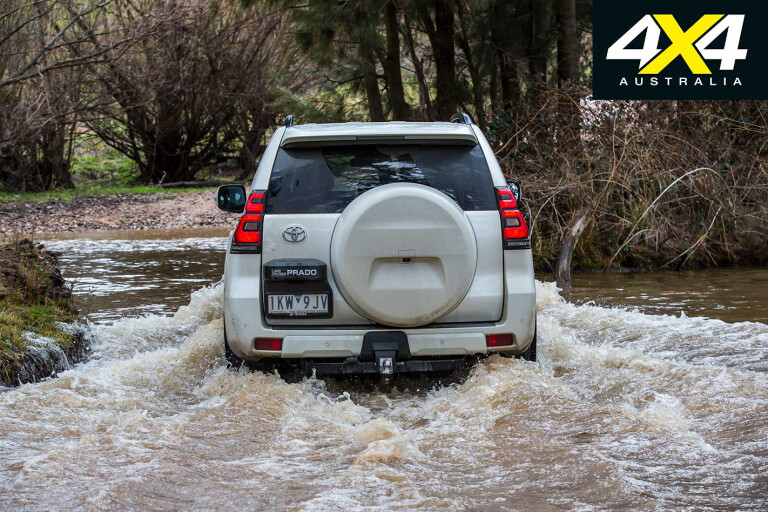
With the Prado weighing more than 2300kg and with its reasonably big profile, 130kW doesn’t go that far and the resulting performance is more adequate than exciting. It’s a little less than what’s on offer with the lighter and smaller Fortuner.
The six-speed automatic doesn’t help in performance either compared to the five-speed as it just adds an extra overdrive ratio rather than tightening up the ratio spread. Fifth is actually a little taller than it was and then there’s the extra gear on top of that, all of which leads to some shuffling between fifth and sixth at typical highway speeds on undulating country roads.
However, like the engine, the six-speeder does bring refinement with smoother and sharper shifts.
All in a Spin

If you think the engine in the Prado is identical to the one in the Fortuner, you’d be wrong. The Prado’s has two counter-rotating balance shafts located just under the crankshaft, a feature missing in the Fortuner, even if the two engines are otherwise identical.
The balance shafts are there to smooth out a twice-engine-speed vibration that’s inherent in all inline fours. The Fortuner gets away without the balance shafts as the 2.8-litre four in question was specifically designed for the new Hilux and derived Fortuner, and the inherent vibration can be largely nullified in the design of the co-developed chassis and body structure.
In the case of the Prado, the new 2.8 engine was retrofitted into an existing chassis/body structure so the vibration would have been more evident and not acceptable given Toyota’s pursuit of refinement.
On-Road Ride and Handling

THE PRADO is a refined, quiet and comfortable-riding wagon with a chassis that offers more in terms of stability than it does in agility. On tight winding roads it’s quick to body-roll and understeer if pushed hard and at the test car’s GXL spec level, there’s no Kinetic Dynamic Suspension System (KDSS) to help – even as an option. KDSS provides notably flatter handling and less understeer via auto tensioning swaybars but is only fitted to VX and Kakadu models.
As is, the GXL isn’t a bad handling wagon, but it’s not as sharp as the light and nippier-feeling Fortuner on tight roads. The Prado’s general highway-speed stability is better than Fortuner, even if there’s still some bump-steer from the rear live axle on potholed roads and the like, especially at higher speeds.
One of the defining differences between these two Toyotas is that the Prado has full-time 4x4 whereas the Fortuner has basic part-time 4x4 shared with Hilux. The Prado’s full-time 4x4, with its mechanical limited-slip centre diff, offers ease of use and safety benefits over the Fortuner on variable road surfaces and on wet gravel and wet bitumen. It also means you can use low-range without locking the centre diff, which can be handy for general manoeuvring when towing and on steep boat ramps and the like.
Off-road
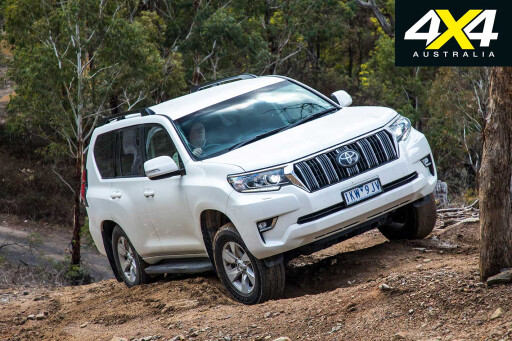 AS EVER, wheel travel is one of the defining elements of off-road ability and a strong point of the Prado. With KDSS the travel would be better than it is (an extra 100mm at the rear axle) but, as mentioned, that’s not fitted to the GXL.
AS EVER, wheel travel is one of the defining elements of off-road ability and a strong point of the Prado. With KDSS the travel would be better than it is (an extra 100mm at the rear axle) but, as mentioned, that’s not fitted to the GXL.
Even so the Prado has more travel than the Fortuner and does things generally easier on broken ground as a result, even if the Fortuner has slightly more clearance and feels smaller and easier to place in a tight track, thanks in part to better vision from the driver’s seat.
Prado GXL also now gets a driver-operated rear diff lock as standard, but when you engage the locker the electronic traction control (ETC) is cancelled on both axles so it’s not necessarily of benefit. As it is the Prado’s ETC works really nicely off-road, even if it’s very noisy.
Cabin and Accommodation
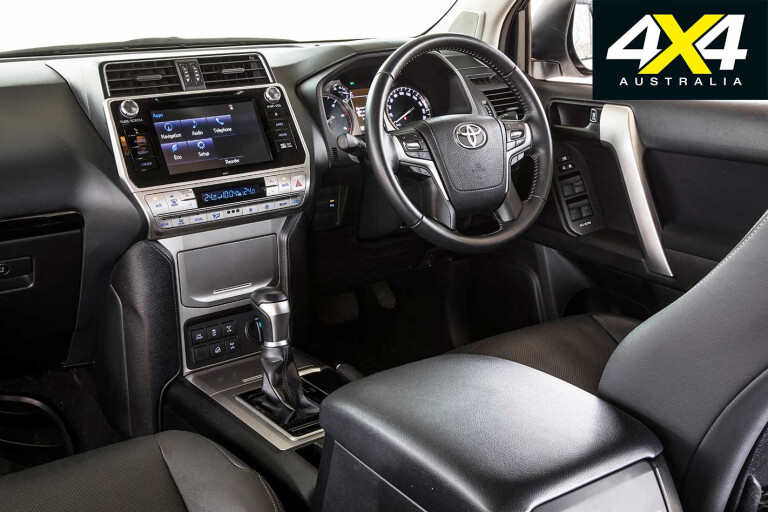
THE PRADO offers a taller and wider cabin than the Fortuner and the driving position feels more upright. Heated and cooled front seats are a nice touch as a GXL option and something you can’t get on any Fortuner – even if the Crusade does have heated front seats.
The Prado beats the Fortuner for rear-seat space for three adults, but isn’t particularly comfortable in the middle for an adult while the Prado’s generally bigger cabin helps with more space for bigger kids or even adults in the third row seat.
Prado’s luggage space height is compromised by having the third row fold into the floor, but is still handy enough with the seats folded. This of course is not a problem in the five-seat GX Prado.
What you get
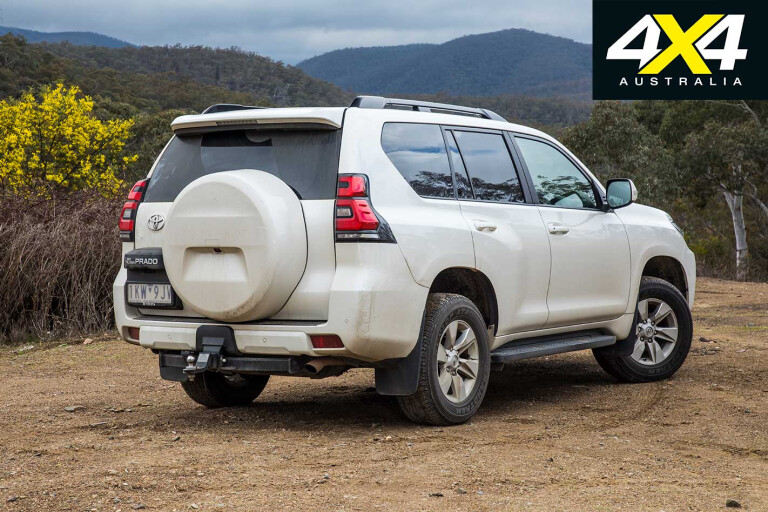
ALL PRADO models from the $53,490 GX manual up come with seven airbags, smart-key entry and stop/start, sat-nav, rear-view camera, and cruise control. All autos (+ $3000 for GX and GXL) models have autonomous braking, radar cruise control, lane-departure warning and auto high-beam.
Over the GX, the GXL ($55,990 for manual) adds third-row seats (an option on the GX auto), side-steps, dual-zone climate and LED headlights and DRLs. Auto GXL can be optioned with a ‘premium’ interior (leather, heated/cooled front seats, heated second-row and electric adjust for front seats for an extra $3500).
The auto-only $73,619 VX has the premium interior as standard and adds power-folding third row, 18s instead of 17s, KDSS (see text), auto headlights and wipers, blind-spot monitoring, rear cross-traffic alert and a ‘panoramic-view’ monitor.
The $84,119 top-spec Kakadu adds memory seats, cool box, rear DVD, Crawl Control, Multi-Terrain select, and adjustable dampers and height-adjustable rear suspension operated via the new ‘Drive Mode Select’ system.
Practicalities
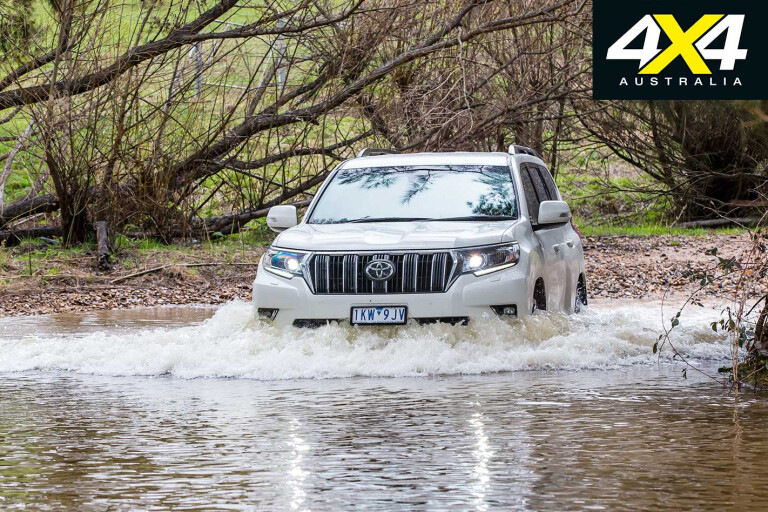
NOTHING much is more practical than a Prado, even one straight out of the showroom given the 150-litre fuel capacity and functional 17-inch wheel and tyre spec. Even the stock S-rated Dunlop Grandtreks are reasonably robust for an OEM tyre. There’s plenty of room under the gas-strut bonnet for a second battery as well, plus the usual inner-guard engine-air intake.
And if you’re unhappy with any of this, tyres included, there’s no shortage of aftermarket enhancements available for the Prado.
Toyota Fortuner

THE FORTUNER arrived in Australia in late 2015 literally off the back of the then all-new eighth-generation Hilux. See, the Fortuner is effectively a Hilux with a wagon body and coils rather than leaf springs at the rear.
The engine, gearbox(s), 4x4 system, front suspension and all, but the tail end of the ladder-frame chassis, are all straight Hilux. This saves development costs in designing and building a 4x4 wagon and is a common ploy used by manufactures in gaining an incremental benefit from their strong-selling utes.
If Ford didn’t do Everest off Ranger, Toyota may not have bothered with the Fortuner. But it felt Everest could trouble Prado sales-wise as Ranger has troubled Hilux, so the Fortuner for Australia became a goer. And it was an easy decision to make given this new Fortuner had undergone development in Australia and was already slated for south-east Asian markets and elsewhere.

Deciding on what name to use was probably more of an issue given Toyota could have revived the well-regarded 4Runner badge as used on Hilux-based wagons sold here from 1984 to 1996.
Following indifferent sales for the first two years, the 2018 Fortuner range saw the prices slashed by at least $5000 and equipment added. Most notably the base GX model gained alloy wheels in place of the black steel wheels shared with Hilux, the mid-spec GXL gained sat-nav, while the top-spec Crusade gained heated front seats and an 11-speaker premium audio system.
Powertrain and Performance

THE FORTUNER shares its 2.8-litre diesel, or at least most of it, with the Prado. Unlike the variant of this engine in Prado there are no balance shafts to help smooth out the typical four-cylinder vibration.
Not that it needs it as the engine is almost as smooth in the Fortuner as it is in the Prado. It’s also generally more enthusiastic, given it powers a smaller and 200kg lighter vehicle. A shorter action throttle also makes the Fortuner feel lively compared to the comparatively lazy Prado. Also, there’s more engine noise in the Fortuner compared to the better insulated Prado.
If the Prado’s performance is adequate, then the Fortuner is adequate, plus a tiny bit. That’s even despite the fact it shares the same flexible and willing character of the Prado’s version of this engine.
On-Road Ride and Handling
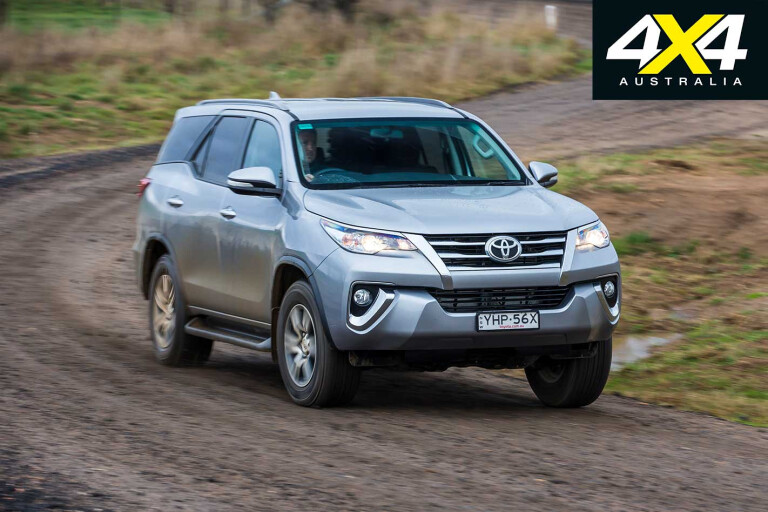
THE FORTUNER doesn’t ride as smoothly or as quietly as the Prado, but it’s still not as bad given that the latter does ride-quality refinement very well indeed. If you’re used to a dual-cab ute, however, or at least an unladen one, the Fortuner will feel like heaven in terms of ride quality.
Compared to the Prado, the Fortuner also feels smaller, more nimble and it has better steering feel when pressed hard. On tight roads it definitely feels the sportier of the two, if that is what you want in your 4x4 wagon.
On the downside, the Fortuner is a little more twitchy and unsettled on bumpy roads at higher speeds than the Prado with more noticeable bump steer from the rear live axle. On some roads you can actually feel the Fortuner’s commercial DNA come through where the Prado feels more polished and passenger-vehicle like.
Off-road
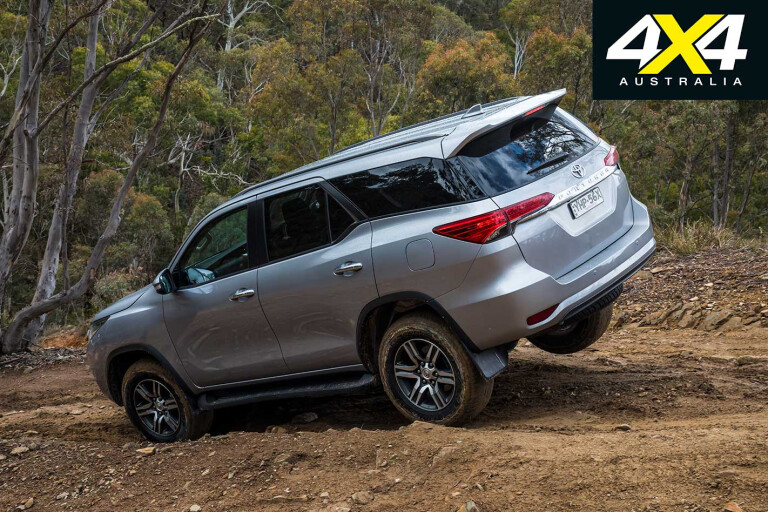
Surprisingly the coil-sprung Fortuner has less rear-wheel travel than the leaf-sprung Hilux from which it is derived. Where the Hilux boasts a class-leading 520mm the Fortuner has 440mm, which is 25mm less than a Prado even without KDSS. There’s less wheel travel at the front of the Fortuner, too, compared to the very supple Prado.
In most situations the Fortuner can do what the Prado does, even if it works a little harder to get the same job done. However, it does come with a little more clearance and better vision from the driver’s seat, so there’s really not much in it in difficult off-road conditions.
All Fortuner models come with a driver-switched rear diff lock, but like the rear locker on the Prado, this cancels the electronic traction control on both axles. Thankfully the Fortuner’s traction control has a specific off-road tune and is noticeably quieter than the relatively clunky-sounding system in the Prado… a case of the Fortuner’s ETC being a generation newer?
Cabin and Accommodation
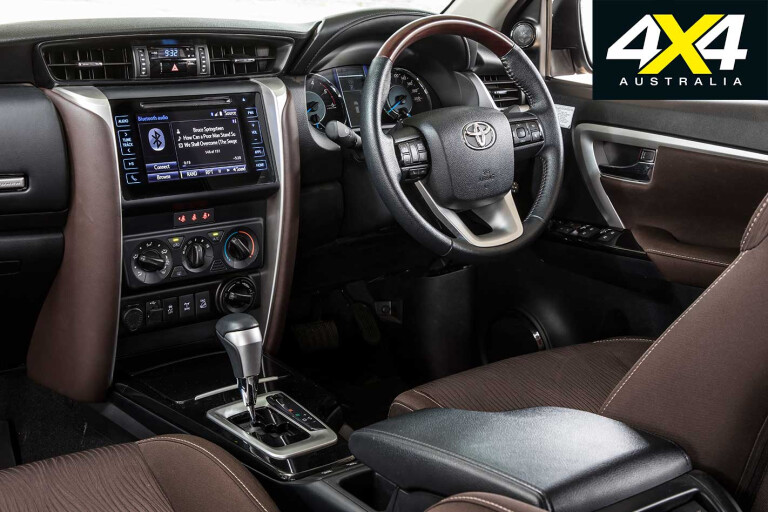
CLIMB into the Fortuner’s cabin and it feels narrower and lower than the spacious Prado. Still, it’s easy enough to get comfortable thanks in part to the Fortuner having tilt-and-reach steering wheel adjustment, which is something missing from most ute-based wagons, Everest included.
The Fortuner’s third row is tighter for shoulder and headroom than the Prado, but is similar in legroom and has a more comfortable middle position. There’s easier third-row entry and exit than the Prado, but once in place the Fortuner’s third-row seat isn’t as well suited to bigger kids or adults.
Unlike the Prado whose third row folds into the floor, the Fortuner’s third-row folds up against the side windows, which gives a deeper, but narrower load space. No tie-down rings in the luggage space of the Fortuner is an annoying negative compared to Prado.
What You Get
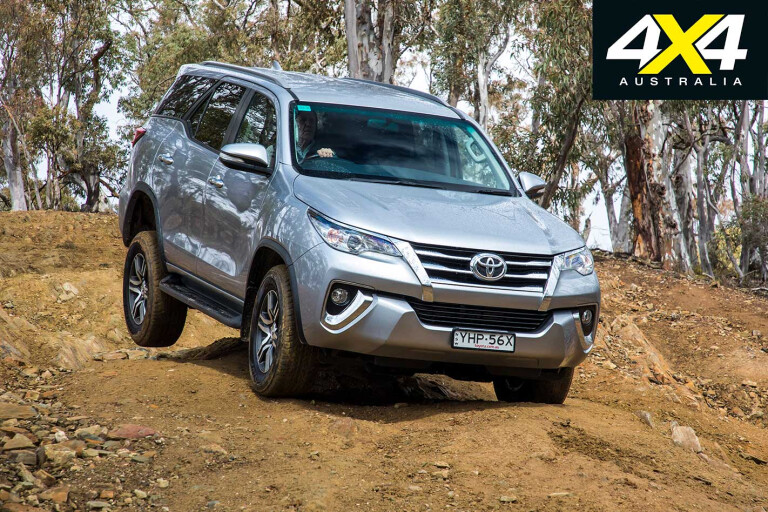
All Fortuner models come with seven seats, tilt-and-reach steering wheel adjustment, a cool box, auto headlights, reversing camera, rear parking sensors and a rear diff-lock. Over and above the GX, the GXL adds ‘smart key’ entry, push-button start, sat-nav, a seven-inch touchscreen, roof rails, front fog lights and rear parking sensors. Leather and electric adjust driver and passenger seats are available as an option on the automatic GXL.
The Crusade has leather and electric-adjust/heated front seats as standard and adds a premium JBL audio system, climate control, power tailgate, 220-Volt socket, 18s, LED headlights and DRLs. Prices start at $42,590 for the GX manual, $47,490 for the GLX manual and top out at $56,990 for the Crusade. GX and GXL models come with the option of an automatic gearbox (adds $2000) while the Crusade is auto only.
Practicalities
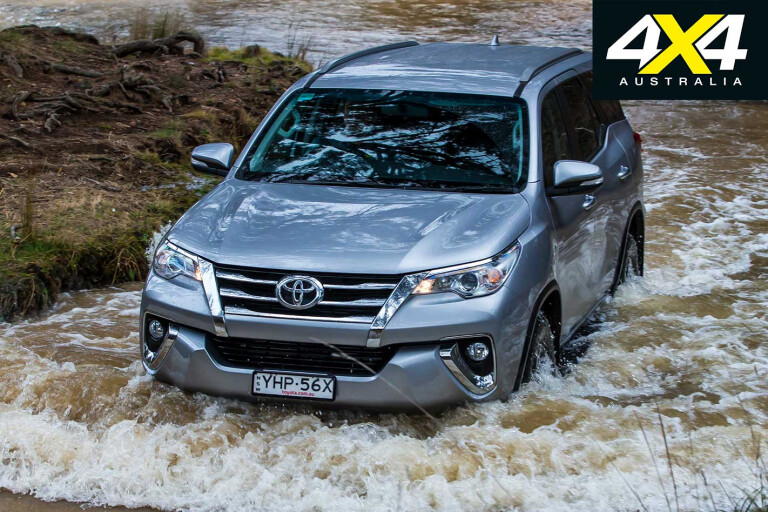
THE FORTUNER matches the Prado for practicality for the most part, but has a much smaller fuel tank (80 litres v 150 litres) than the ‘standard’ Prado models. New Prado variants (now in GXL, VX and Kakadu) with the spare wheel under the vehicle and a separately opening tailgate glass have an 87-litre fuel capacity.
As an automatic, the Fortuner has a 2800kg towing capacity, which is 200kg less than Prado automatic. As a manual, however, the Fortuner matches the Prado’s 3000kg and betters the Prado manual by 500kg.
Fortuner has the same practical wheel and tyre spec as Prado, a similar air-intake for the engine and there’s also room for a second battery in the engine bay, even if the available space isn’t as much as it is with Prado.
What’s in a Name?
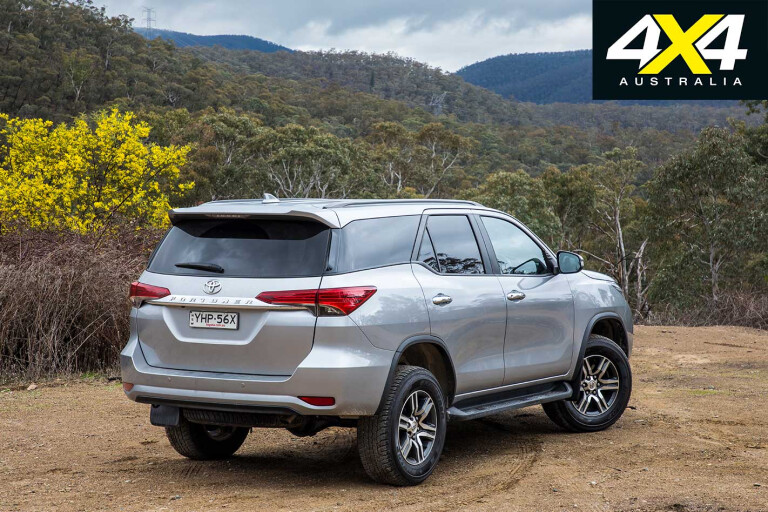
Fortuner as a Toyota model name only arrived in Australia in October 2015, but the Fortuner’s predecessors were here as early as 1984 badged as 4Runners. Like the Fortuner, the 4Runner was a wagon made from a Hilux ute, initially by doing not much more than slicing off the rear of the ute’s cabin and adding a fibre-reinforced plastic canopy on the tray. Even the rear leaf springs were retained.
The second-generation 4Runner, introduced in 1989, moved much closer to what we have now in the Fortuner with the introduction of an all-metal body and coil springs at the rear.
The Verdict

BEFORE its significant 2018 price reduction, the Fortuner made a less convincing ‘buy-me’ argument against the Prado than it does now. And how you judge the two against one another is dependent on whether you’re a features-driven buyer or one more concerned with a vehicle’s inherent core value.
No doubt the Fortuner makes its best case as the entry-level GX, especially now Toyota has ditched the very ordinary looking black-painted steel wheels. The Fortuner GX manual undercuts the Prado GX manual by $10K and comes with third-row seating as standard, something not available with the Prado GX manual at all.
If you want a GX Prado with seven seats you first have to opt for the automatic gearbox (+$3000) and then the third row is an additional $2550. All of which means you can have a Fortuner with seven seats for $15K less than a seven-seat Prado.
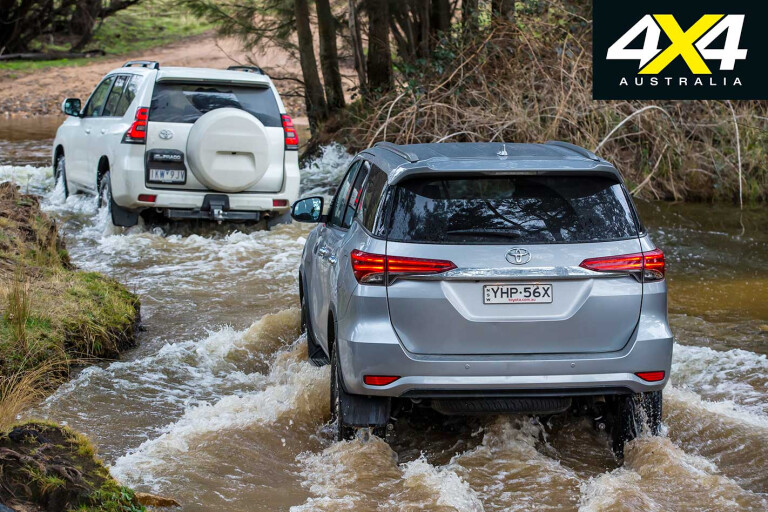
The auto option on Fortuner ($2000) is also cheaper than the Prado, although the auto box in the Prado brings with it a raft of additional safety features and a higher 3000kg tow rating.
The higher-grade Fortuner models also make a good argument features-wise against the Prado given a Fortuner Crusade is a similar price to a five-seat Prado GX automatic. What the Fortuner can’t match, however, is the fact that the Prado is inherently a better vehicle.
It’s bigger, quieter, more refined, more composed at higher speeds on bad roads, marginally better off-road, has near twice the fuel capacity and it offers the considerable benefit of full-time 4x4.
The choice is yours…
Specifications
| Toyota Prado GXL | Toyota Fortuner GXL | ||
| Engine | 2.8-litre 4-cyl turbo diesel | ||
| Power | 130kW at 3400rpm | ||
| Torque | 450Nm at 1600-2400rpm | ||
| Gearbox | Six-speed automatic | ||
| 4x4 System | Dual-range full-time | ||
| Crawl Ratio | 36.1:1 | ||
| Construction | Separate-chassis | ||
| Suspension (f) | Independent/coil springs | ||
| Suspension (r) | Live axle/coil springs | ||
| Kerb Weight | 2325kg | 2122kg | |
| GVM | 2990kg | 2750kg | |
| Payload | 665kg | 628kg | |
| Towing Capacity | 3000kg | 2800kg | |
| GCM | 5990kg | 5545kg | |
| Departure angle | 25˚ | 25˚ | |
| Rampover angle | 22˚ | 23.5˚ | |
| Approach angle | 32˚ | 30˚ | |
| Wading Depth | 700mm | 700mm | |
| Ground Clearance | 220mm | 225mm | |
| Fuel Capacity | 150 litres | 80 litres | |
| ADR Fuel Claim | 8.0L/100km | 8.6L/100km | |
| Test Fuel Use | 11.7L/100km | 10.8L/100km | |

COMMENTS